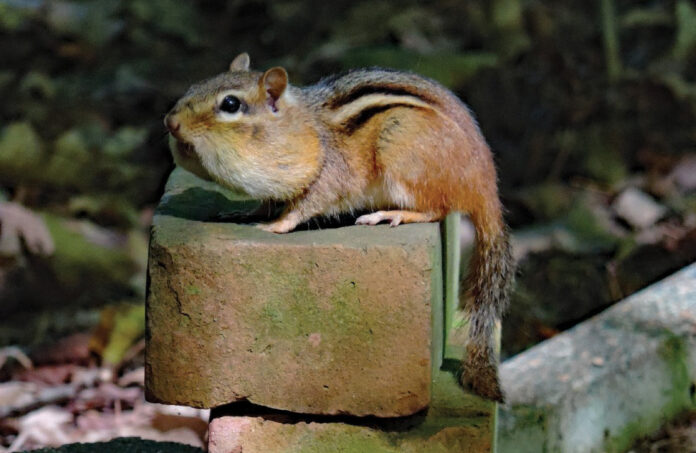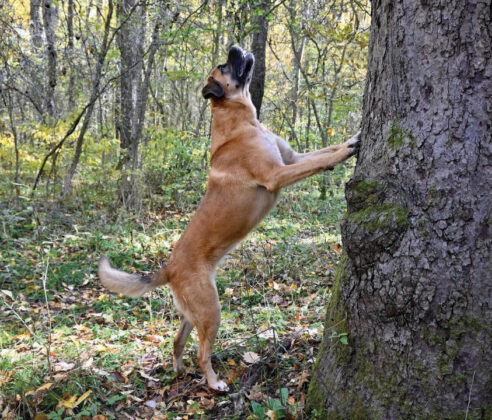
Northeast Ohio is home to five different species of squirrels. These include (from largest to smallest) the eastern fox squirrel, eastern gray squirrel (the black squirrel is just a color morph of the gray), American red squirrel, southern flying squirrel and last and certainly least, the eastern chipmunk (Tamias striatus).
Plenty of personality
As its species name, striatus, implies, the chipmunk is a rodent named for its conspicuous markings. A prominent white stripe down each of its sides bordered by black and topped off by a dark stripe down the center of its back gives the impression of racing stripes. Light-colored lines above and below the eyes complete the outfit. Measuring just 10 inches in length, including the tail, the chipmunk’s diminutive size does not detract from its larger-than-life personality.
Extremely expressive, the chipmunk gets its common name from the variety of chip-like vocalizations it produces. Its cuk-cuk-cuk calls which echo through the woods have confused many a birder. The variety of chips and chipping trills it broadcasts function to both advertise the animal’s territory to other chipmunks, as well as warn of approaching predators. You may hear a chipmunk nearby long before you even, if ever, see it.
Here at my place, chipmunks abound! They are especially busy this time of year and drive my dog, Pearl, crazy. She spends the majority of her outdoor time studying their activity and very patiently waiting for them to become distracted with their duties. Then, without notice, she dives toward them, inevitably causing them to scramble up the nearest tree and a waiting game ensues.
Living underground
Yet, chipmunks are far from arboreal. Of all these squirrel species, the chipmunk is the only ground squirrel and they spend considerable amounts of time excavating a network of tunnels and burrows which may reach well over three feet underground. It is the protection of these underground dens that allows them to produce two litters per year, one in early spring and another in late summer.
Chipmunk abodes become obvious in autumn as accumulations of chewed nuts or hulls accumulate at their entrance. In general, chipmunks are solitary and highly territorial, interacting with males only during breeding season.
Chipmunk cheeks
If there is one thing we recognize about the chipmunk, it is its tendency to appear with the chubby-cheek syndrome during the autumn months. The chipmunk’s cheeks are glorified pouches that are lined with soft, dry fur in which to store and transport food into their subterranean burrows.
Have you ever watched a chipmunk beneath your bird feeder? As it moves along it picks up seed after seed after seed. Before long, you can see its cheeks expanding. In fact, up to 60 black-oil sunflower seeds can fit into each pouch. Of course, the larger the item, the fewer can fit but one thing is true, the pouches can stretch up to three times the length of the animal’s head giving the impression of having swollen glands … or the mumps.
Once its cheeks are full, the chipmunk returns to its burrow. Special “rooms” within are used for the sole purpose of storing this fare. You see, although chipmunks seem to disappear when winter sets in, they are not true hibernators. Yes, they take long winter naps, but when they awake, the large caches of food they have worked so hard to accumulate keep them alive. On a warm winter day, chipmunks will appear briefly above ground, but they quickly return to their abodes to ride out the winter.
Chipmunks have a varied diet that includes seeds, nuts, berries, fruits, flowers, mushrooms, insects, worms, snails and frogs. They also have an affinity for eating bird eggs, which can be a detriment to many ground-nesting species.
Loved or loathed?
Although they have not been known to cause serious agricultural damage, many consider chipmunks a nuisance, especially in the garden where they feed on fruits, seeds, seedlings and may exhume flower bulbs.
Yet, like every organism on this earth, chipmunks play an important role in the ecosystem, whether or not it happens to benefit us. Their burrowing helps aerate and recycle soil. When feeding on and storing fungi, they help to spread spores. They also play a critical role in dispersing seeds. Most importantly, chipmunks are an incredibly important food source for hawks, owls, snakes, weasels, coyotes, foxes and raccoons which depend heavily on rodents for their diet. Suffice it to say, loved or loathed, the charismatic eastern chipmunk is here to stay!
(A lifelong resident of Geauga County in northeast Ohio, Tami Gingrich recently retired from a 31-year career as a Biologist/Field Naturalist with Geauga Park District. Tami has been a licensed bird bander for over 30 years. Her hobbies include photography, lepidoptera, gardening and spending time with her husband on their small farm in Middlefield, Ohio. She welcomes any questions or comments at Royalwalnutmoth@gmail.com and will gladly consider suggestions for future articles.)
















thanks for info.